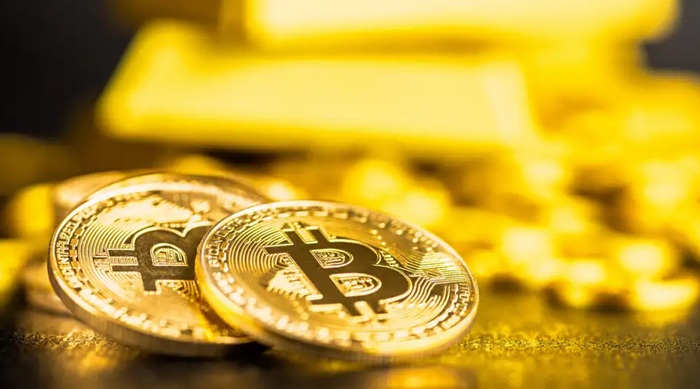
It’s been a happy few weeks for those who hold stocks of gold and bitcoin in their trading arsenals. The commodities have both reached record highs as investors continue to back them.
Gold smashed through the $3,900 (€3,334) a troy ounce barrier this week — a troy ounce being the unit of weight for precious metals and equivalent to 31.1 grams.
Meanwhile, on Sunday (October 5), the world’s oldest and best-known cryptocurrency, bitcoin, hit a record when it broke through the $125,000 barrier for the first time, before falling back a little.
It has so far been a bumper 2025 for both commodities. Gold has been on its biggest rally since the 1970s, with the price jumping by more than 50% since January 1. Bitcoin has had some falls during a turbulent 2025, but its value has risen by around a third since the start of the year.
Why is it happening?
Long seen as a so-called safe-haven asset which investors back during periods of uncertainty, gold has been on a steep upward curve since late 2018, with its value having increased by more than 300% since then.
Uncertainty has been a factor in the current rally, with US President Donald Trump’s reciprocal tariffs in April fuelling concerns over the global economy, the sustainability of US government debt levels and the future viability of the US dollar as the world’s reserve currency.
There has also been ongoing geopolitical uncertainty as a result of Russia’s war in Ukraine and the war in Gaza.
Another recent factor has been the US government shutdown. Gold is widely seen by investors as an alternative option to the US dollar, which has fallen sharply in value this year.
Gold has also benefited from a fall in support for the Japanese yen as a safe-haven asset. Japanese stocks surged on Monday after it was confirmed that Sanae Takaichi was elected as leader of the ruling party LDP, setting her up to be the nation’s first female prime minister. However, the yen continued to fall back.
“Yen weakness on the back of the Japanese LDP elections has left investors with one less safe-haven asset to go to, and gold was able to capitalise,” KCM Trade Chief Market Analyst Tim Waterer told news agency Reuters.
The US situation was adding to the attraction of gold. “The enduring US government shutdown means that a cloud of uncertainty still hangs over the US economy, and the potential size of any GDP impact,” he added.
However, experts say there is more to gold’s current surge than doubts over the future of the US economy or indeed, the global economy. Several analysts say there has been a rise in demand for gold-backed exchange traded funds (ETFs), with more and more investors from a wider range of backgrounds seeking to invest.
“The fact that ETF demand has re-entered the scene so forcefully means that there are two forms of ‘aggressor’ bids for gold, from central banks and ETF investors,” wrote Deutsche Bank analysts in a note to clients.
Gold has long been purchased by central banks around the world but the new ETF demand has fuelled the current rally. Recent data from the US Commodity Futures Trading Commission (CFTC) shows that hedge funds now hold record holdings of $73 billion worth of gold.
What about bitcoin?
Bitcoin’s record rally has been largely driven by the reelection of Donald Trump as US President, with his clear and often-stated support for cryptocurrencies helping to increase demand and trust in the sector.
However, there is evidence that more institutional investors are ploughing into bitcoin, similar to the trend seen with gold. The commodity is becoming favored as an alternative to other bets, such as the US dollar. Expected interest rate cuts are also apparently luring investors to take greater risks on the asset.
Bitcoin also appears to be strengthening on the back of uncertainty over the US economy, with the ongoing government shutdown driving up demand.
“The shutdown matters this time around,” Geoffrey Kendrick, head of digital assets research at Standard Chartered Bank, wrote in a note to investors.
“This year, bitcoin has traded with ‘US government risks,’ as best shown by its relationship to US Treasury term premium,” he added, referring to the metric which measures the extra yield investors demand in order to hold long-term government bonds — which reflects the extent of their faith in long-term economic stability.
Another factor in bitcoin’s current strength may be related to its annual cycle. October has historically been one of its strongest months, with the price having only fallen twice during the month of October since 2013.
Can the rally continue?
Many observers see gold and bitcoin continuing to rise in value, with new milestone breakthroughs expected.
“I suspect bitcoin will rise throughout the shutdown and will soon reach $135,000,” Geoffrey Kendrick predicted. The fact that the Trump administration is likely to continue pursuing favorable policies for cryptocurrencies adds to the sense of optimism.
As for gold, few see it losing value anytime soon.
“Rallies can continue into 2026 aided by official sector buying; institutional demand for gold as a diversifier can stay robust,” HSBC said in a note to investors on Friday.
The London, UK-based bank said it expected central banks to continue buying gold in large quantities as an ongoing hedge against geopolitical risk.
That chimes with what the World Gold Council said in its last quarterly statement in late July, that its annual central bank survey showed that “95% of reserve managers believe that global central bank gold reserves will increase over the next 12 months.”
That, along with the growing demand around ETFs from hedge funds and other institutional investors, suggests the commodity is likely to breach the $4,000 mark soon. (DW)
